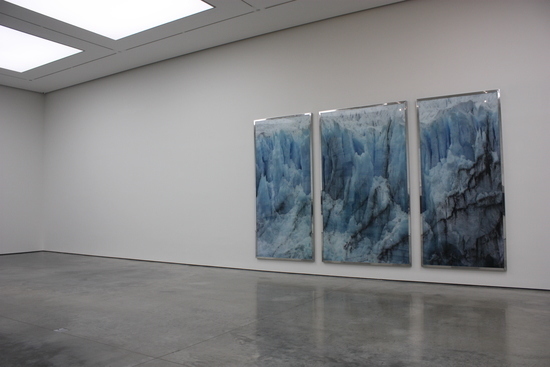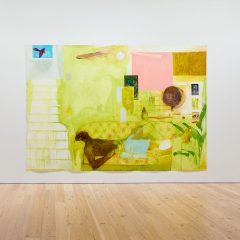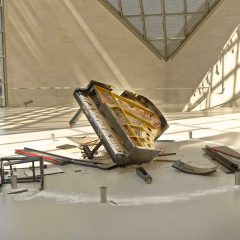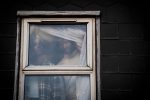[Katie explores two London shows that treat light in very different ways, from moonlit nature photographs to abstract, colorful glass sculptures — the Artblog editors]
Light does much to connect us with the world. Its ricocheting rays tell volumes about what’s around us, from the expression on the face of a friend to the condition of a distant star. It’s little wonder, then, that light is an object of fascination and exploration for artists, who play with perceptions that most of us take for granted.
Darren Almond‘s long-exposure moonlight photos, now showing at White Cube, play explicitly with the idea of light as a variable medium, offering subtly and intriguingly different images to contrast the ones to which we are used. The sea becomes a cloud of probabilities; double-imaged leaves present a record of their fluttering in some midnight breeze.
Rooted on Earth, Almond reaches for the moon
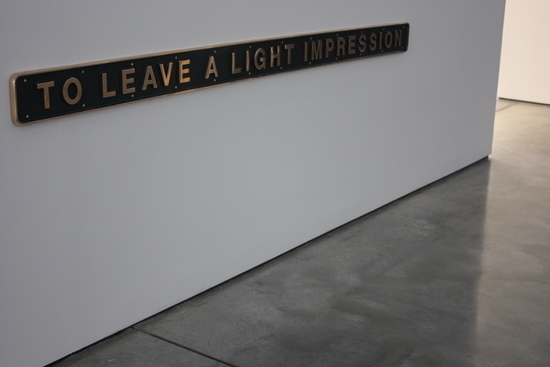 One can feel time passing in these photographs, perhaps thanks to an awareness of the machine producing the image, or a subtle change in light from the moon’s progression in the sky. It’s interesting to become conscious of the mechanism of the eye, to consider the paths of light beams through that internal chamber, which tell us about movement and form.
One can feel time passing in these photographs, perhaps thanks to an awareness of the machine producing the image, or a subtle change in light from the moon’s progression in the sky. It’s interesting to become conscious of the mechanism of the eye, to consider the paths of light beams through that internal chamber, which tell us about movement and form.
This mechanism, however, is complicated by the form of these prints. The large regions of darkness in these prints become mirrors, and in some cases, the photographs themselves are obscured.
In the second series of photos, the standing stones on the Isle of Lewis, Scotland, show up crisp and detailed against a luminous cloudy sky. These stones are records of mankind’s remarkable drive to count and so control the passage of time; this precise recording of their visual form shows the heights that this control has reached.
 In the same room, pairs of brass cylinders lie scattered across the space. Each cylinder represents an astronaut who has walked on the moon, its interior packed with lead to represent the astronaut’s relative weight. It’s a comment both on the ways that our bodies interact with the earth and the moon, and on the abstracting qualities of measurement.
In the same room, pairs of brass cylinders lie scattered across the space. Each cylinder represents an astronaut who has walked on the moon, its interior packed with lead to represent the astronaut’s relative weight. It’s a comment both on the ways that our bodies interact with the earth and the moon, and on the abstracting qualities of measurement.
The back wall of the show is dominated by three enormous panels, a vast tripartite of deep, veined, blue ice from the Perito Moreno Glacier, seeming to glow from thick silver frames. In the right hands, this stunning image also imparts information; the accompanying text explains that the blue color indicates the prehistoric nature of the ice, revealed thanks to humanity’s impact on the environment.
Lush glass sculptures play with light and shadow
Impressive in a very different way is the heavy load borne by the glass panels that form the roof of the pagoda-like structure at the centre of Dale Chihuly‘s show at Halcyon Gallery. Scattered across its surface are a menagerie of the intensely colored shapes for which Chihuly is known: trumpets, spires, and delicate shells that hover somewhere between the marine and the floral.
 Under this carpet, the viewer is transfixed, constantly repositioning to find a new frame, watching and experimenting with the interplay of light and contrasting, combining color. Though the rest of the show is more traditionally presented, the investigation carries on in the subtleties revealed by the light cast greedily over the surfaces of the room. The lines of illumination, as in a swimming pool, reveal something of the form of the glass, each bump and ripple casting refractions in waves across the walls.
Under this carpet, the viewer is transfixed, constantly repositioning to find a new frame, watching and experimenting with the interplay of light and contrasting, combining color. Though the rest of the show is more traditionally presented, the investigation carries on in the subtleties revealed by the light cast greedily over the surfaces of the room. The lines of illumination, as in a swimming pool, reveal something of the form of the glass, each bump and ripple casting refractions in waves across the walls.
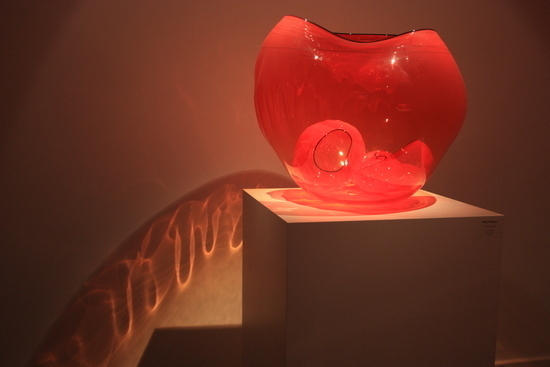 Most fascinating are the black-and-white pieces resting like underwater skeletons inset in a shining black cabinet. Here, the reflections go wild–intense contrasts rebounding but muted, the black edging a delineation of these fascinating explorations of pattern and interference.
Most fascinating are the black-and-white pieces resting like underwater skeletons inset in a shining black cabinet. Here, the reflections go wild–intense contrasts rebounding but muted, the black edging a delineation of these fascinating explorations of pattern and interference.
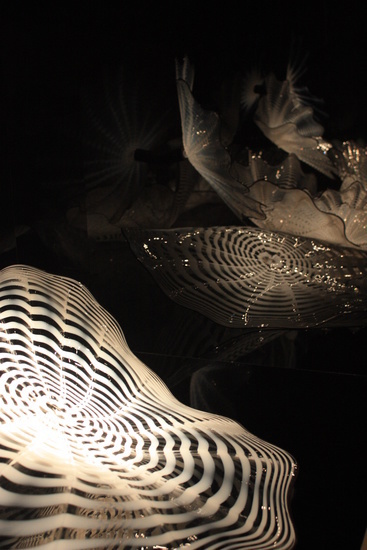 Chihuly’s works are intensely magnetic; deep, red-orange cups, resting one inside the other, are reminiscent in their sumptuousness of Georgia O’Keefe’s semi-erotic flowers, warm and seductive. Chihuly’s standing in the fine art world is perhaps undermined by the enjoyable luxury of his work. He is often labelled a craftsman, a tag given to diminish the depth of his thinking. Where Almond’s works explore topics that leave the earth and investigate the processes that have allowed us to achieve such things, Chihuly seems firmly tied to the body.
Chihuly’s works are intensely magnetic; deep, red-orange cups, resting one inside the other, are reminiscent in their sumptuousness of Georgia O’Keefe’s semi-erotic flowers, warm and seductive. Chihuly’s standing in the fine art world is perhaps undermined by the enjoyable luxury of his work. He is often labelled a craftsman, a tag given to diminish the depth of his thinking. Where Almond’s works explore topics that leave the earth and investigate the processes that have allowed us to achieve such things, Chihuly seems firmly tied to the body.
Considering placement and medium
But though Chihuly’s work stays securely in the realm of the sensual, that does not render it superficial; rather, the sense of light and form that one can explore in walking around these objects allows an understanding of space that could not be expressed in words. Furthermore, the artist displays a perfect knowledge of the physicality of his medium, unlike Almond’s reflective photo-displays.
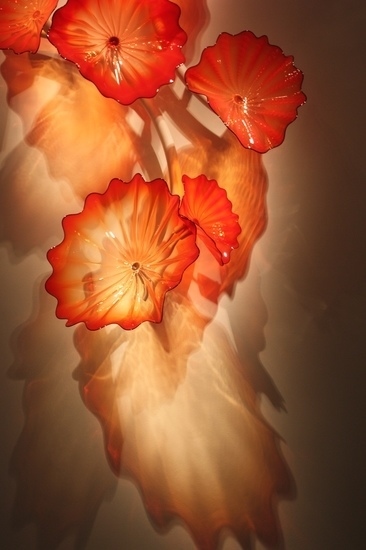 While Almond’s show is thought-provoking and profound, I feel that this kind of investigation may be better experienced in a publication like Fullmoon, a hardcover book published by the artist in March. While Chihuly’s works certainly center around an exploration of beauty, his works teach us just as much about perception and space, though perhaps by a route less shaped by concepts and words.
While Almond’s show is thought-provoking and profound, I feel that this kind of investigation may be better experienced in a publication like Fullmoon, a hardcover book published by the artist in March. While Chihuly’s works certainly center around an exploration of beauty, his works teach us just as much about perception and space, though perhaps by a route less shaped by concepts and words.
Darren Almond’s To Leave a Light Impression can be seen at White Cube in London, UK until March 12th, 2014.
Dale Chihuly’s Beyond the Object can be seen at Halcyon Gallery in London, UK until April 5th, 2014.


